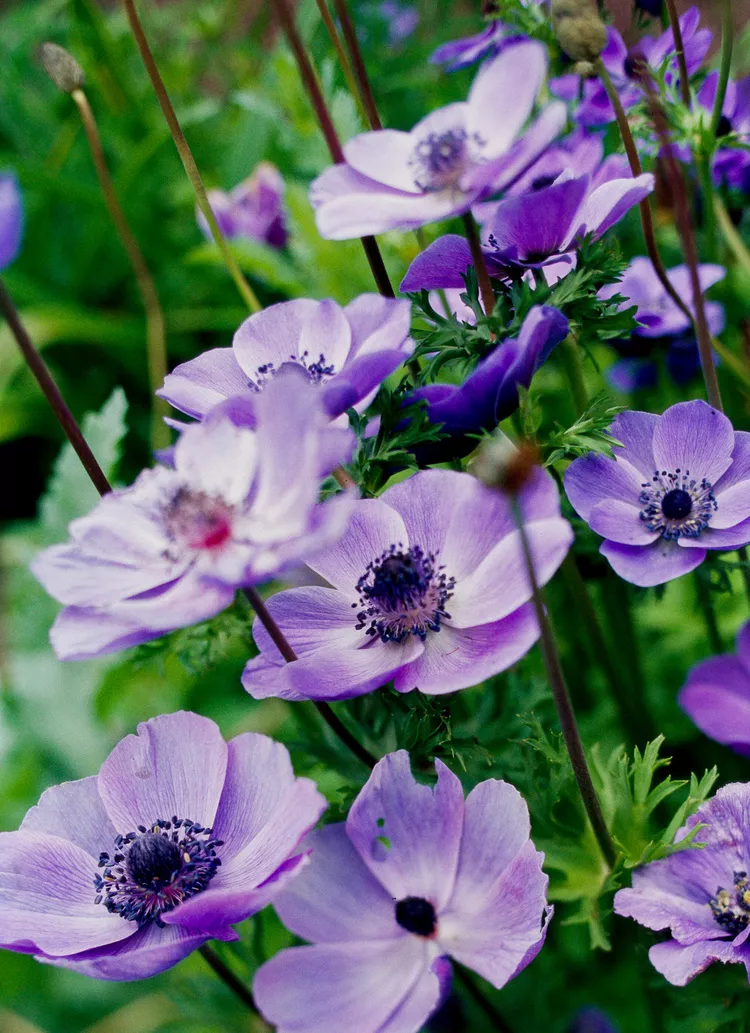How to Plant and Grow Anemone Bulbs

Anemones, which are a close relative of buttercup, share that plant’s natural charm. Bulb-type anemones are easy to grow, spreading their early spring cheer beneath still-bare trees and shrubs. Their daisylike flowers feature thin, silky petals that quickly disperse in a breeze after flowering. Their colors range crisp white, sky blue, and pinkish purple complements crocus and snowdrop early in the season before tulips grab the spotlight. Anemones are also a good choice for a cut flower to use in springtime bouquets.
Note: Bulb-type anemones are different than fall-blooming anemones—also called Japanese anemone or windflower—which are perennials that brighten the late-season garden. This larger plant comes in many shades of whites and pinks with petals arranged in either single or double rows.
Anemone Bulbs Overview
| Genus Name | Anemone |
| Common Name | Anemone Bulbs |
| Plant Type | Bulb |
| Light | Part Sun, Sun |
| Height | 6 to 12 inches |
| Width | 4 to 10 inches |
| Flower Color | Blue, Orange, Pink, Purple, Red, White, Yellow |
| Foliage Color | Blue/Green |
| Season Features | Fall Bloom, Spring Bloom |
| Special Features | Cut Flowers, Good for Containers, Low Maintenance |
| Zones | 5, 6, 7, 8 |
| Propagation | Division |
| Problem Solvers | Drought Tolerant, Good For Privacy, Groundcover, Slope/Erosion Control |
Where to Plant Anemone Bulbs
Anemones are somewhat small, spring-blooming bulbs, so plant several where you can enjoy their floral beauty up close. Site them along paths and walkways, as well as at the front of the border around a deck or patio. Another eye-pleasing option: Create mass plantings in other parts of the yard so you can enjoy dozens of anemones as a carpet of color in spring.
You can also grow anemones in containers. If you're in an area where the containers won't freeze solid over winter, you can leave them outdoors. Otherwise plant the pots in fall, move them to a garage or shed, and then bring them out as temperatures warm in spring.
How and When to Plant Anemone Bulbs
Plant anemone bulbs in early fall as soil temperatures begin to cool. You can continue planting through the autumn, right up until the soil freezes and you can't get a shovel in the ground.
Caring for Anemone Bulbs
Light
Anemone bulbs bloom most profusely in full sun (at least six hours of direct sun per day) but tolerate part shade well. However, too much shade will reduce the number of flowers. Because they go dormant in early summer, anemone bulbs ideal for beds and borders beneath deciduous trees, such as oaks and maples. You only have to worry about them getting enough sun until the foliage starts to turn yellow.
Soil and Water
Anemones are easygoing when it comes to soil, but they reward you with best performance if planted in areas that are moist, well-drained, and rich in organic matter. If your soil has a high clay content, amend liberally at planting time with organic matter like peat moss, compost, or coconut coir.
Pests and Problems
Easy-care anemones are deer- and rabbit-resistant, making them an excellent choice for woodland areas and other places frequented by these creatures. When anemone bulbs are happy, they reproduce quickly—forming beautiful clusters that add a carpet of springtime color to the yard. In shadier plantings, keep an eye out for powdery mildew, which can be a mild nuisance.
Types of Anemone Bulbs
Wood Anemone
Wood anemone (Anemone nemorosa) is an early-spring bloomer with 1-inch white blooms. Plants go dormant in summer but carpet large areas of woodland in spring. Zones 4-8
Double Wood Anemone
Double wood anemone (Anemone nemorosa 'Bracteata Pleniflora') is a showy variety that features extra petals in its white flowers. It grows less than 1 foot tall. Zones 4-8
Companion Plants for Anemone
Anemones have daisylike blossoms that complement the cup-shape flowers of crocus. And blue-purple Greek anemone puts on a vibrant show when planted alongside orange or yellow pansies. They partner well with groundcovers like vinca, dianthus, and creeping phlox (Phlox stolonifera).